- Guides
- B2B
-
Climbs
-
Climb Elbrus
- Elbrus individually
- Elbrus from the South, 9 days
- Elbrus from the South, 7 days
- Elbrus from the South in 1 day
- Elbrus from the North
- Elbrus Two Summits
- Elbrus Traverse South to North
- Elbrus Traverse North to South
- Elbrus "Cross" from South
- Elbrus "Cross" from North
- Kazbek+Elbrus
- Elbrus from the West
- Elbrus by helicopter
- Elbrus holidays, 9 days
- Elbrus holidays, 7 days
- Tinder Tour: Climbing Mount Elbrus
- Climb Elbrus from the South, 9 days with Sergey Baranov
- Under 5000 m
- 5000+ meters
- 6000+ meters
- 7000+ meters
- 8000+ meters
-
Climb Elbrus
-
Trekking
-
See 8000m
- K2 base camp
- Everest base camp
- Everest base camp via Gokyo
- Everest base camp in a week
- Annapurna circuit
- Trekking the Manaslu Circuit
- Trekking to Kanchenjunga Base Camp
- Trekking to Kanchenjunga Base Camp (Short)
- Trekking to Kanchenjunga Base Camp (India)
- Trekking to Makalu Base Camp
- Trekking to Annapurna BC
- South America
- Asia
- Africa
- Russia
- Europe
-
See 8000m
-
Adventures
-
Africa
- Tour to Morocco for New Year
- Morocco: Toubkal and the mysteries of the Sahara
- Tour to Eritrea: Dahlak Archipelago and Rashaida Nomads
- Tour to Rwanda: Mountain Gorillas and Mount Bisoke
- Ethiopia
- Tour to Uganda: Queen Elizabeth National Park and Mountain Gorillas
- Safari Tanzania
- Safari Uganda
- Tour to Zimbabwe and South Africa: Victoria Falls, Cape Town, and Cape of Good Hope
- Namibia
- Safari Kenya
- Tour to Botswana: Okavango Delta and Chobe National Park
- South America
- Asia
-
Africa
- Ski-touring
- VIP
- Useful
- About
Climb Elbrus from the South, 7 days
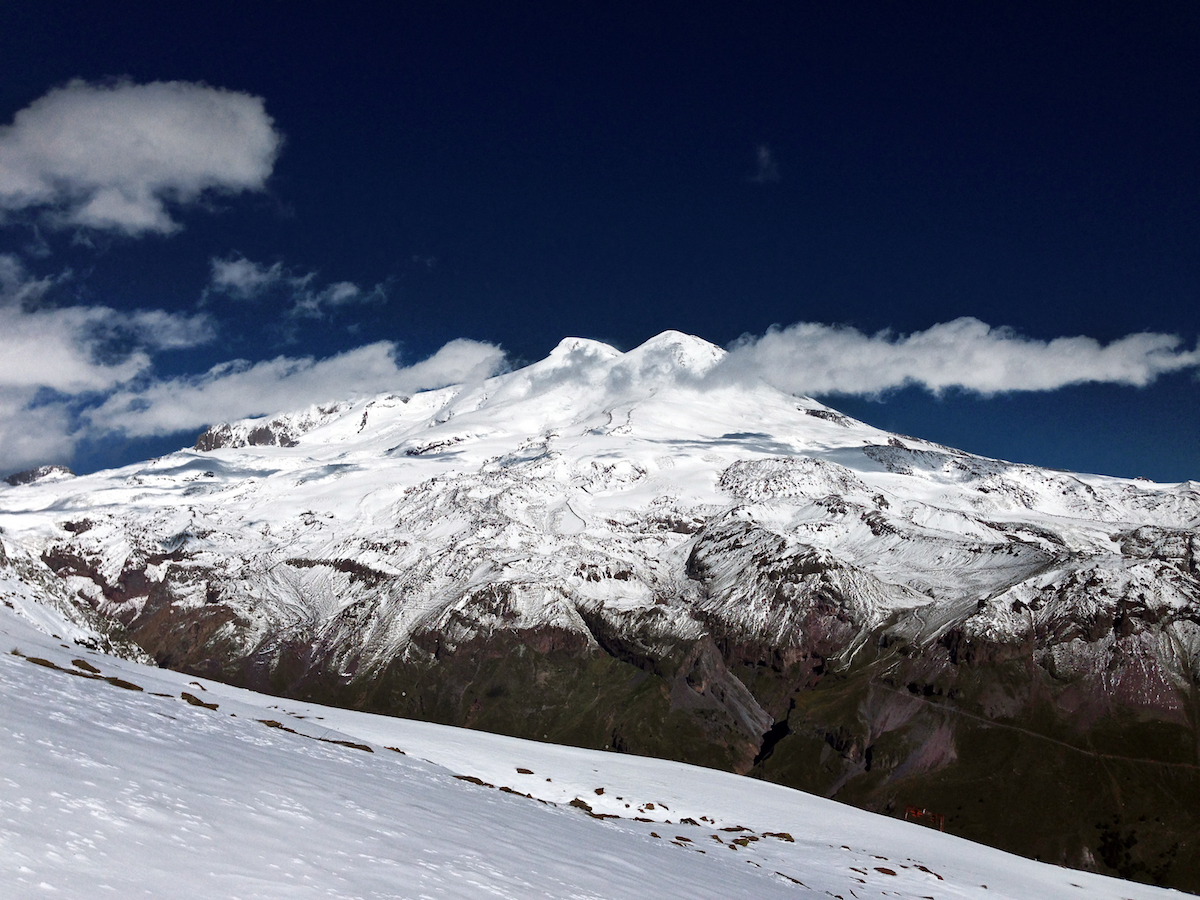
1500 $
Why to go with us?
Temporarily unavailable
This program is a variant of our 9-day Elbrus climbing program. We recommend such an ascent to those who have climbing experience or very good physical shape, all hopes of "climbing on willpower", on "luck" are usually groundless, height is height. This version differs from the original in that one day of acclimatization on Cheget is excluded and the day of dropping off at the shelter is combined with access to the Pastukhov rocks. As a result, the risk of noticeable discomfort during the acclimatization period at altitudes of 4000 + meters and on the day of climbing Elbrus increases. However, the percentage of reaching the top of Elbrus is practically the same as the nine-day program. In addition, there is an opportunity to take advantage of the recreation program in the Elbrus region if someone close to you wants to join you, but will not climb to the top.
Important information:
Наверх- Check-in and check-out time is regulated by the hotel: check-in from 15 o'clock, check-out from the hotel until 11-12 o'clock. You can leave your luggage at the hotel reception and walk around the area, or, if technically possible, pay extra for early check-in/late check-out.
- Any exit from the shelter on the day of the ascent is an attempt.
- For foreign citizens, if necessary, we make guest invitations to our tours.
About the tour
Everyone wants to go to Elbrus in a week. But acclimatization is a very important process for those who climb in the highlands, as it allows the body to adapt to the changed conditions and reduce the risk of acute conditions such as altitude sickness, pulmonary edema, cerebral edema and others. During acclimatization, the body begins to produce more red blood cells, which increases the amount of oxygen that can be delivered to muscles and organs, including the brain and heart. This helps to reduce the symptoms of altitude sickness such as headache, nausea and fatigue.
In this program, climbing to the top of Elbrus is carried out on the fifth day (the fourth active day), that is, in any case, acclimatization will be partial. A snowmobile on the day of ascent can make your feat easier, but it will not go to the top of Elbrus for you. It is worth sensibly assessing your strength and experience, all the risks, and comparing this climbing program with others. No matter what anyone says, altitude affects everyone in absolutely different ways, someone climbs to the top of Elbrus after arriving from the airport (based on our experience, we estimate these chances as 10%), and for someone on the seventh day it is still not super easy.
We strongly recommend watching a lecture by our most experienced Elbrus guide about Elbrus.
7-day Schedule for an Elbrus Climb from the South.
Day 1. Meeting at the Mineralnye Vody airport. Transfer from the airport at 12:00-12:15 for climbers arriving on flights before 11:30. Transfer from the airport at 15:15-15:30 for all arrivals before 14:45. Transfer 190km (about 3 hours) to the hotel. The hotel is located in the upper reaches of the two-kilometer valley of the Baksan River, at the foot of the Elbrus in the village of Terskol, 2000 meters above sea level. A general gathering at dinner. Briefing — strictly after dinner, the guest must be fed first, and then stuffed with knowledge. The briefing. Overnight at the hotel.
Day 2. In the morning we make an acclimatization trekking to the waterfall “Devichy Kosy” (2700m), from where we climb further to the observatory (3100m). On this day, it’s good to take a little snack, because sometimes lunch turns out to be late, and hypoglycemia prevents you from perceiving the beauty and enjoying the insanely beautiful views of the Elbrus mountains. After lunch, we customize the rental of equipment with everything that will be useful to us when climbing Elbrus, there is absolutely everything here. Overnight at the hotel. The climb is 1200m 13km.
Day 3. Final fees at the hotel, short transfer (4km) to Azau, to the cable car. She (with two transfers) will bring us and our countless loads to the Gara Bashi station, from where our shelter is just around the corner. Accommodation in a shelter. 3888m. After a light (we don’t save money, it’s just difficult at altitude with a full stomach) lunch-snack — acclimatization trekking to a height of 4,600 meters — this is the lower part of the Pastukhov rocks. There is no point in going higher, otherwise the night will not be easy. Overnight at the shelter. The climb is 712m. 6 km.
Day 4. Rest day. Self-retention classes in the snow (if there is snow. At the end of the summer, there are problems with this, classes are then replaced by theory, alas), training in the use of snow and ice equipment, instruction on movement along the railing. It is necessary to walk well (but save energy, so classes are always close to the shelter) and get enough sleep! Overnight at the shelter.
Day 5. Ascent to the Western peak of Elbrus (5642m). Early start at 2-4 am (according to the decision of the main guide), it is possible to use a snowmobile for ascent and / or descent, the decision to ascend is made early in the afternoon, the decision to descend is made on the spot, during the descent from the top. Discussing and thinking about these issues in advance is useless, as practice shows. The ratio of guides to clients is always strictly 1:3. Overnight at the shelter. The climb is 1754m. 14km.
Day 6. Reserve day. Descent to the hotel by cable car. In the morning, if the ascent was successful on day 5, or in the afternoon, if the ascent takes place on that day. Overnight at the hotel.
Day 7. Departure to the airport at 7 a.m. (pay attention when planning your departure!). If the flight is late or you just want to explore the south of Russia a little more, then you can leave your things in the airport luggage room, take a taxi and go to Pyatigorsk (on your own): visit the place of M.Y. Lermontov’s duel, the Sinkhole, the observation deck, from where, in addition to an excellent view of Pyatigorsk, the lucky ones will also see Elbrus
Not included in the cost of Elbrus climb:
- Ratrak on the day of ascent (if necessary, it is paid on the spot), we never force anyone to use ratrak!
- Single accommodation
- Perm National Park (if relevant)
- Early check-in/late check-out from the hotel before/after the program (we always try to negotiate with our partners about additional bonuses for our guests, often we are allowed early check-in/late check-out for free)
- Personal equipment (this is what you personally wear and what you personally use)
- Any deviations from the program.
- Any costs associated with program changes
- Medical insurance
- Tips
Insurance
НаверхList of equipment for climbing mount Elbrus from the South.
Скачать PDFDocuments
- Valid passport
- Airline tickets
- Voucher (a form, which was sent to you for obtaining visa)
- Insurance
Personal equipment
- Backpack
- Sleeping bag
- Ski/trekking poles be sure to have rings of at least 70 mm
- Crampons
- Ice axe
- Mountaineering Lanyard.
- Helmet
- Harness
- 2 Carabines
- 2 meters of 5 or 6-10mm rope
Clothing and shoes.
- Wind and waterproof layer – Pants and Jacket. Gore-Tex, for example.
- Fleece pants and jacket
- Thermo underwear layer – top and bottom
- Dawn jacket.
- Mittens
- Thick gloves
- Thin gloves
- Bandana
- Warm hat
- Underwear, socks and so on
- Some warm socks for a summit day
- Balaclava
- Windproof face mask
- Gators
- Trekking shoes/trekking boots
- Double or triple boots
Travel Accessories
- Headlamp
- Shower accessories, toothpaste, toothbrush
- Sunglasses
- Ski goggles
- Vitamins
- Thermos (1 liter, better without button)
- Sunblock and lip balm
- Personal medical kit
- Spare contact lenses or glasses
- Knee supports
You may also like
-
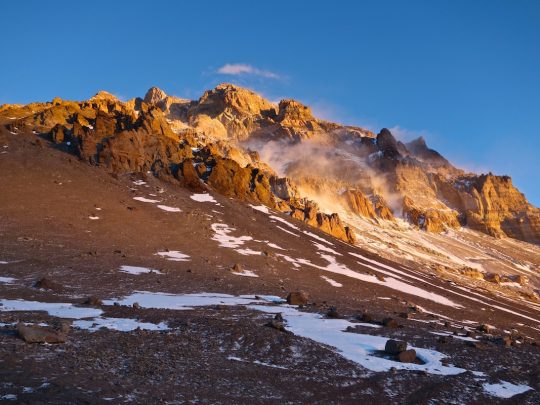 6,650 $
6,650 $Climb Aconcagua, 17 days
- Height (m)
- 6957
- Duration
- 17 days
- Difficulty
- Moderate
- Continent
- South America
- Children
- From 14 years old
- Accomodation
- There are tents
-
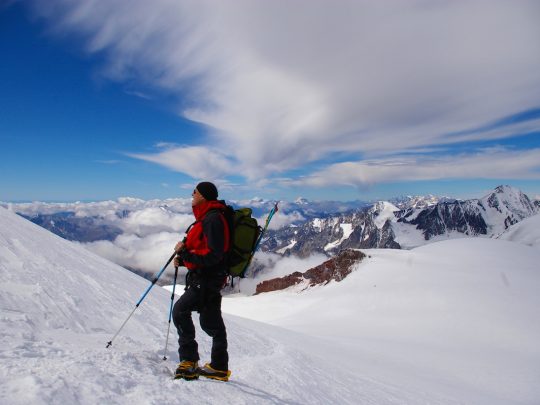 1,900 $
1,900 $Climb Kazbek+Elbrus
- Height (m)
- 5642
- Duration
- 10 days
- Difficulty
- Moderate
- Continent
- Europe
- Children
- From 14 years old
- Accomodation
- Without tents
-
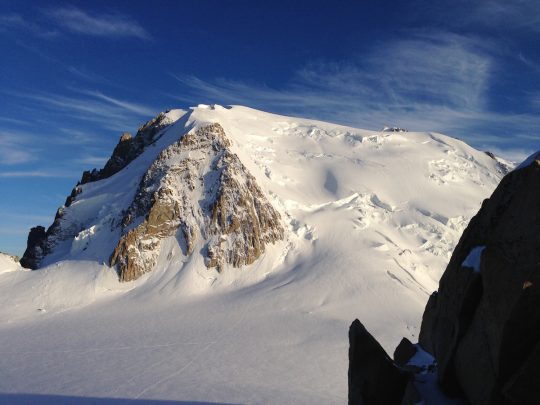 2,690 $
2,690 $Climb Mont Blanc
- Height (m)
- 4810
- Duration
- 7 days
- Difficulty
- Moderate
- Continent
- Europe
- Children
- From 14 years old
- Accomodation
- Without tents
-
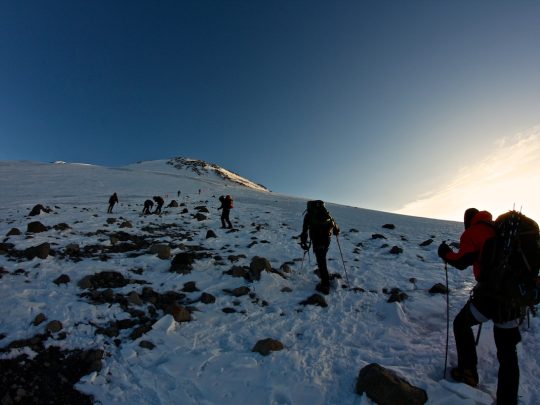 2,100 $
2,100 $Elbrus Traverse South to North
- Height (m)
- 5642
- Duration
- 9 days
- Difficulty
- Low
- Continent
- Europe
- Children
- From 14 years old
- Accomodation
- Without tents